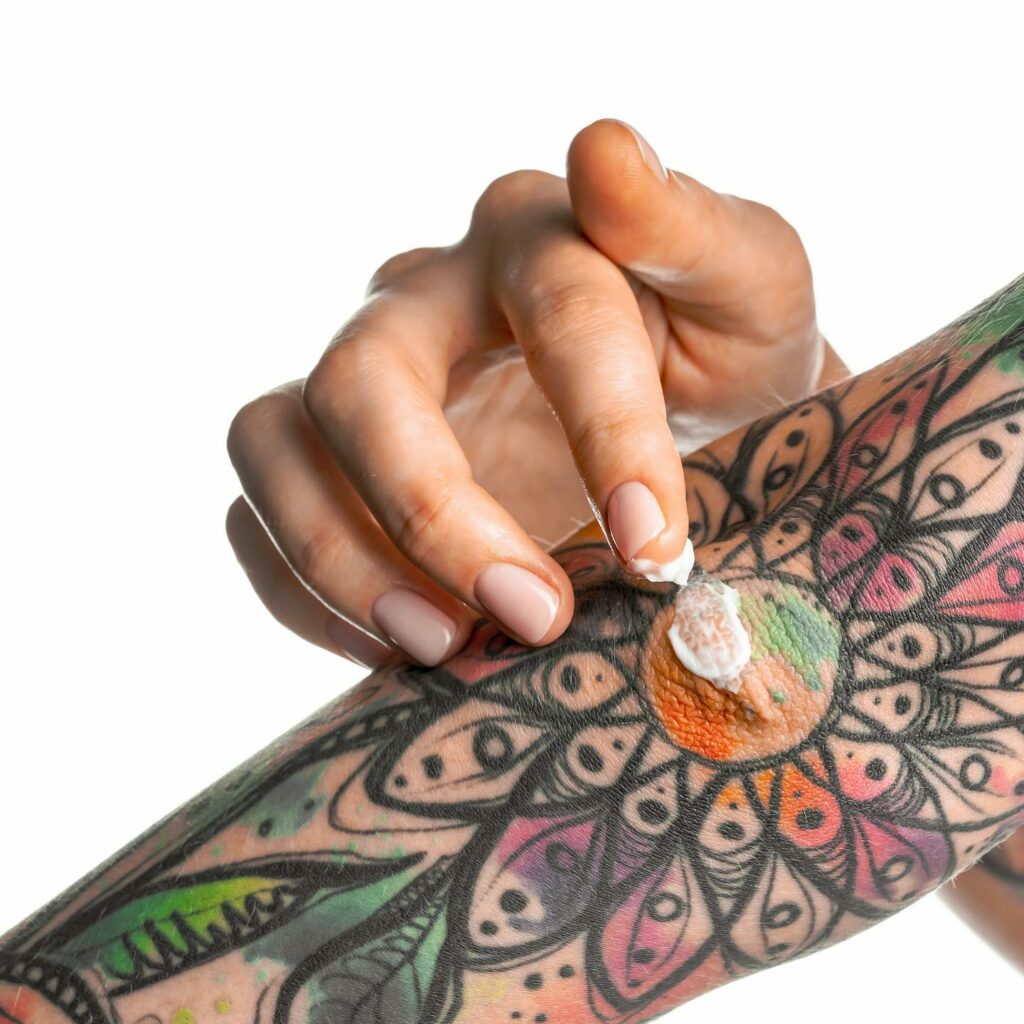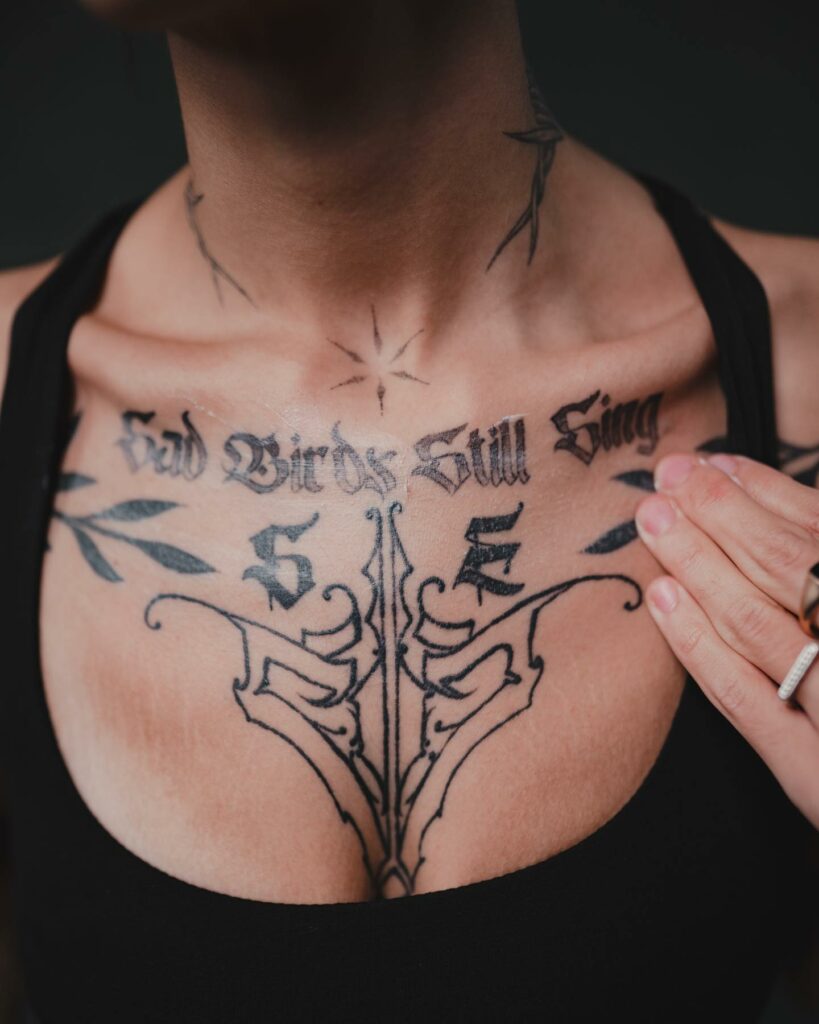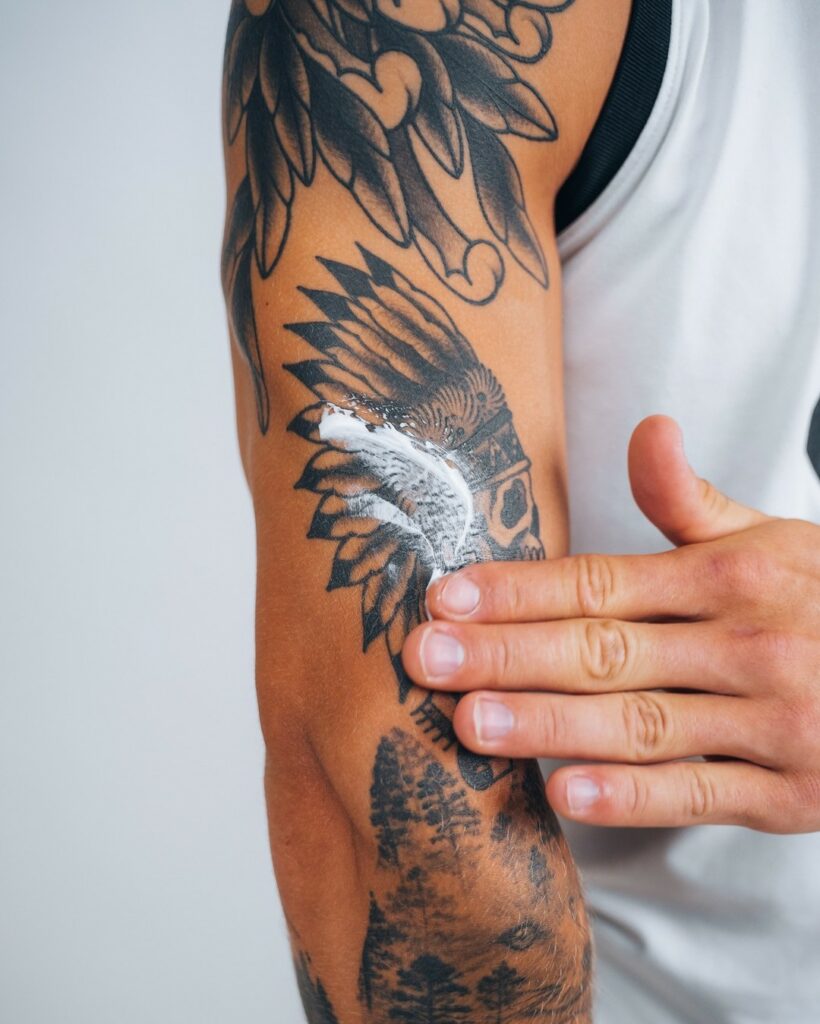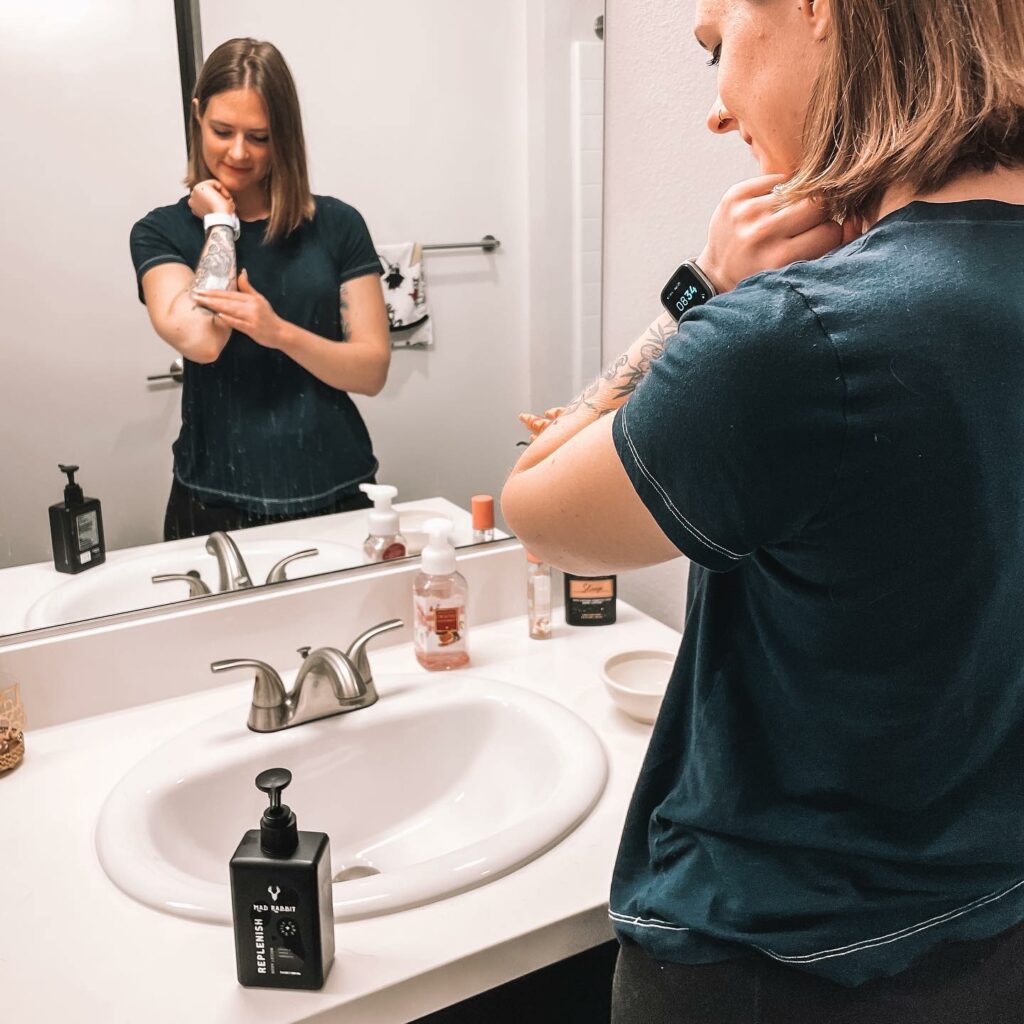Table of Contents
I’m sure most of you, either as a seasoned canvas or a fresh inductee to the tattoo club, have asked or been asked the million-dollar question: “To Aquaphor, or not to Aquaphor?” Well, that’s what we’re cracking into today. We’ll be diving under the skin (metaphorically, of course) to decode the mysteries of Aquaphor and its role in the post-tattoo process.

In this post, we’ll brush up on the importance of post-tattoo care, the science behind Aquaphor, its pros and cons, and how to apply it effectively to preserve your body art. By the end, you’ll walk away not only with a fresh understanding of this staple in tattoo care but also with a treasure trove of tips to keep your ink vibrant and your skin happy.
Think of this as your interactive guide to the crossroads of art and skincare, with yours truly, the ink maiden, as your guide. The world of tattoos is as deep as the ink that graces our bodies, and together, we’ll dive into its complexities. Whether you’re a tattoo titan or a complete newcomer, this blog post is your gateway to understanding the significance of Aquaphor in the tattoo healing process. Let’s demystify and declutter the path to healthy, happy tattoos, one fact at a time. Let’s ink-cise our knowledge, shall we?
What Is Aquaphor?
Imagine this – it’s the late 1990s, and a young Tori has just gotten her first tattoo. The artist hands her a jar of petroleum jelly, the go-to tattoo aftercare of the era. Little did I know then how far we’d come! Fast forward to today, and Aquaphor, an advanced petroleum-jelly-based ointment, is my pick for post-tattoo care. But why Aquaphor? Let’s break it down.

Aquaphor is a potent skin protectant that combines the classic petroleum jelly base with added ingredients such as mineral oil and ceresin for enhanced skin protection. It’s not just a skin soother; its super-smooth consistency makes it a dream to apply without getting sticky, and the added chamomile extract is a natural anti-inflammatory that eases your skin’s healing journey. Oh, and you can use it for various skin issues or just to prevent dry skin! So, that tub of Aquaphor you purchase for your tattoo aftercare? It’s going to serve you well beyond the life of your tattoo’s healing process.
When Should You Use Aquaphor On A Tattoo?
Here’s a fact from my tattoo playbook: Aquaphor is not a lifelong commitment, folks! It’s an integral part of the initial aftercare process. I remember a time when I overused a tattoo ointment – my skin rebelled with a rash that looked like a topographic map! Lessons learned, right? Aquaphor helps speed up the healing process, ensuring your tattoo’s design remains unscathed by irritation, scabbing, or rashes. For most tattoos, a healthy healing period falls between two to three weeks, though it varies depending on factors like tattoo size, design, and your body’s healing pace.
My rule of thumb? Use Aquaphor until the redness and scabbing subsides. For application frequency, once a day is your magic number. If your scabs start feeling mushy or you notice irritation, cut back on your usage. Sometimes, it may be time to switch from a heavy ointment to a lighter, fragrance-free lotion.

How Long Should Aquaphor Be Used On A Tattoo?
No need to smother your tattoo with Aquaphor for an eternity. If your tattoo is healing well, a three-day stint with Aquaphor could be enough before switching to a lighter moisturizer. Just remember to avoid products with heavy fragrances, dyes, or irritating ingredients when transitioning.
Aquaphor and Your Tattoo: The Benefits
Beyond its excellent hydrating prowess, Aquaphor brings a slew of benefits to your fresh ink, just like my favorite rock band’s greatest hits. Here’s what this superstar does:
- Prevents Crusting and Tattoo Damage: New tattoos ooze blood, lymph fluids, and excess ink, which can form a crust on the skin. Aquaphor keeps the skin moisturized, preventing crust formation.
- Reduces Scabbing: All tattoos scab, but Aquaphor helps avoid large, ink-leaking scabs from forming.
- Prevents Infection: Aquaphor forms a protective barrier to keep the bad stuff (dirt and bacteria) out of your fresh tattoo, reducing infection chances.
- Soothes Itchy Skin: Ever had a tattoo itch you couldn’t scratch? I have, and it’s maddening! Aquaphor helps soothe and moisturize the skin, reducing that crazy itch.
- Decreases Healing Time: Aquaphor keeps your tattoo moisturized and bacteria-free, speeding up healing.
The side effect that is not actually a disadvantage

Every superhero has its kryptonite, and for Aquaphor, it’s the occasional mishaps. Some people may experience sensitivity or skin breakouts due to the thick, petroleum jelly base. If you see little bumps or a rash around your tattoo, it might be time to switch your aftercare product.
Sometimes, Aquaphor can create an illusion of leaking more ink than usual. Don’t fret; it’s a classic case of illusion over reality! Aquaphor’s texture might make it seem like you’re losing more ink, but your tattoo will still retain plenty of color when it heals.
How To Use Aquaphor On A Tattoo
Want to get the best out of your Aquaphor experience? Let me guide you through it with a tried and tested, step-by-step process. It’s like applying the perfect coat of paint!
- Remove the bandage/wrap: Remove the bandage as per your artist’s advice. Some artists recommend keeping it on overnight. Remember, patience is the name of the game!
- Clean your tattoo: Gently wash your tattoo with mild soap. Avoid scrubbing or picking at any crusts or scabs. Trust me, I learned it the hard way!
- Dry the tattoo: To avoid trapping excess moisture, pat your tattoo dry with a clean paper towel.
- Apply a thin layer of Aquaphor: Remember, overdoing it can suffocate the skin and clog pores.
- Remove the excess: Use a clean paper towel to dab off extra ointment. And don’t worry, as long as you’re not wiping it off, your tattoo is well protected.

I hope this guide paints a clearer picture of Aquaphor and its role in tattoo aftercare. Keep in mind, everyone’s skin is different, and so are our tattoos. Your journey might be different, and that’s okay. Listen to your skin, follow your artist’s advice, and most importantly, enjoy the beautiful process of watching your tattoo come to life! Happy healing, everyone!
Alternatives to Aquaphor For Tattoo Aftercare
There are several alternatives to Aquaphor for tattoo aftercare, each with its own set of pros and cons. Remember, everyone’s skin reacts differently, so what works for one person might not work for another. Here are a few alternatives:
- Lubriderm: This is a water-based lotion that many tattoo artists recommend. It’s fragrance-free and doesn’t feel greasy, which is a major plus for those who dislike the thick feel of ointments.
- Aveeno: Known for its skin-friendly ingredients and low irritant formulas, Aveeno lotions are great for sensitive skin. They’re also often fragrance-free, which is a bonus when dealing with a fresh tattoo.
- Tattoo Goo: Specially designed for tattoo aftercare, Tattoo Goo offers a range of products from lotions to salves, all formulated to soothe, protect, and enhance the color of your tattoo.
- Bepanthen: Originally a diaper rash cream, Bepanthen is rich in Panthenol (Vitamin B5), which helps to repair the skin and keep it moisturized. Some artists recommend it for the initial healing stages.
- Hustle Butter Deluxe: This vegan-friendly, all-natural tattoo care product can be used before, during, and after getting a tattoo. It can help to keep skin workable, reduce redness, swelling, and bleeding, and aid recovery.
- Cetaphil: A good choice for very sensitive skin, Cetaphil moisturizers are mild, fragrance-free, and unlikely to clog pores.
Always consult with your tattoo artist before switching products or trying something new. They have experience with many different skin types and can provide advice based on your specific needs.
Conclusion
Absolutely, dear reader! Navigating the world of tattoo aftercare can be as intricate as the designs we choose to ink onto our bodies. And amidst the various options, Aquaphor stands as a reliable partner in this journey, with its excellent hydrating properties, protective shield against dirt and bacteria, and ability to speed up the healing process. However, like any good partnership, it’s essential to balance its use. Overdoing it might lead to clogged pores or a possible skin reaction. If you experience any discomfort, it may be time to switch to another product. Remember, less is often more when it comes to application, and the duration should ideally be around three days, with a transition to a lighter moisturizer afterward. Tattoo care, like our body art, is a personal journey. You’re now equipped with a deeper understanding of Aquaphor’s role in tattoo healing. So, go forth, embrace your unique journey, make informed decisions, and enjoy the beautiful evolution of your fresh ink into a permanent piece of your story. Happy tattooing!




